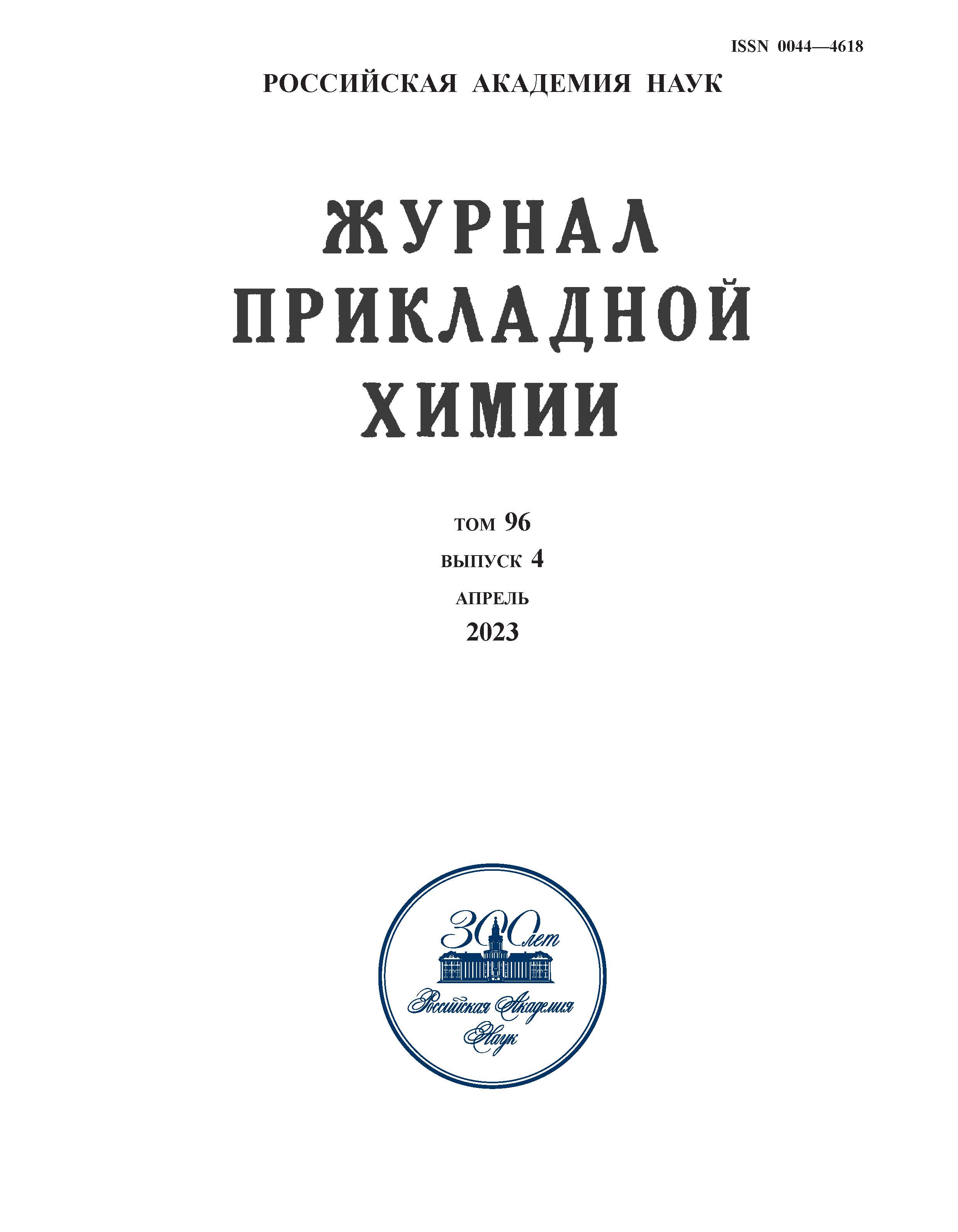Properties of Polymer Films Based on Cellulose Diacetate with Intercalated Zn{(NH2)2Co}2Br2
- 作者: Titov M.I.1, Bush A.A.1, Ageeva T.A.2, Davydova M.N.3, Koyfman A.I.2, Fomichev V.V.1
-
隶属关系:
- MIREA–Russian Technological University (RTU MIREA)
- Ivanovo State University of Chemical Technology
- Lomonosov Institute of Fine Chemical Technologies
- 期: 卷 96, 编号 4 (2023)
- 页面: 363-369
- 栏目: Articles
- URL: https://kld-journal.fedlab.ru/0044-4618/article/view/668149
- DOI: https://doi.org/10.31857/S0044461823040060
- EDN: https://elibrary.ru/OFOZJG
- ID: 668149
如何引用文章
详细
The work is devoted to the fabrication and study of electret material based on cellulose diacetate polymer film with an intercalated active component, polar macromolecules Zn{(NH2)2CO}2Br2. The introduction of macromolecules into the film was carried out during its formation from solutions of various concentrations of cellulose diacetate and Zn{(NH2)2CO}2Br2 in tetrahydrofuran with ethyl alcohol under the action of a constant electric field of 2–4 kV cm–1. The temperature curves of the dielectric constant ε, the dielectric loss tangent tan δ, as well as the thermally stimulated depolarization currents j of the resulting films were determined. It was established that modification leads to the appearance of additional maxima in the ε(T), tan δ(T), and j(T) curves caused by the active component embedded in the film. Modification of a cellulose diacetate film causes an increase in the value of j and the surface charge density found from the j(T) curve by more than two orders of magnitude. The results obtained indicate the possibility of application of the method under consideration to fabricate electret films.
作者简介
M. Titov
MIREA–Russian Technological University (RTU MIREA)
Email: acjournal.nauka.nw@yandex.ru
119454, Moscow, Russia
A. Bush
MIREA–Russian Technological University (RTU MIREA)
Email: acjournal.nauka.nw@yandex.ru
119454, Moscow, Russia
T. Ageeva
Ivanovo State University of Chemical Technology
Email: acjournal.nauka.nw@yandex.ru
153000, Ivanovo, Russia
M. Davydova
Lomonosov Institute of Fine Chemical Technologies
Email: acjournal.nauka.nw@yandex.ru
119571, Moscow, Russia
A. Koyfman
Ivanovo State University of Chemical Technology
Email: acjournal.nauka.nw@yandex.ru
153000, Ivanovo, Russia
V. Fomichev
MIREA–Russian Technological University (RTU MIREA)
编辑信件的主要联系方式.
Email: acjournal.nauka.nw@yandex.ru
119454, Moscow, Russia
参考
- Li X., Wang Y., Xu M., Shi Y., Wang H., Yang X., Ying H., Zhang Q. Polymer electrets and their applications //j. Appl. Polym. Sci. 2021. V. 138. N 19. ID 50406. https://doi.org/10.1002/app.50406
- Guo Z., Patil Y., Shinohara A., Nagura K., Yoshida M., Nakanishi T. Organic molecular and polymeric electrets toward soft electronics // Molecular Systems Design and Engineering. 2022. V. 7. N 6. P. 537-552. https://doi.org/10.1039/d1me00180a
- Ageeva T., Bush A., Golubev D., Gorshkova A., Kamentsev K., Koifman O., Rumyantseva V., Sigov A., Fomichev V. Porphyrin metal complexes with a large dipole moment //j. Organomet. Chem. 2020. V. 922. ID 121355. https://doi.org/10.1016/j.jorganchem.2020.121355
- Голубев Д. В., Румянцева В. Д., Фомичев В. В. О термической устойчивости комплекса висмута(III) иод этиопорфирин II // Тонкие хим. технологии. 2017. Т. 12. № 1. С. 26-30. https://doi.org/10.32362/2410-6593-2017-12-2-26-30
- Savinkina E. V., Efimova N. A., Grigoriev M. S., Davydova M. N., Fomichev V. V., Ageeva T. A.Complexes of zinc halides with amide ligands having a high dipole moment //j. Coord. Chem. 2022. V. 75. N 3-4. P. 362-371. https://doi.org/10.1080/00958972.2022.2054704
- Sousa M., Bras A. R., Veiga H. I. M., Ferreira F. C. Dynamical characterization of a cellulose acetate polysaccharide //j. Phys. Chem. B. 2010. V. 114. P. 10939-10953. https://doi.org/10.1021/jp101665h
- Einfeldt J., Meibner D., Kwasniewski A. Polymer dynamics of cellulose and other polysaccharides in solid state-secondary dielectric relaxation processes // Progr. Polym. Sci. 2001. V. 26. P. 1419-1472. https://doi.org/10.1016/S0079-6700(01)00020-X
- Bao C. Y., Long D. R., Vergelati C. Miscibility and dynamical properties of cellulose acetate/plasticizer systems // Carbohydrate Polym. 2015. V. 116. P. 95-102. http://dx.doi.org/10.1016/j.carbpol.2014.07.078
补充文件









